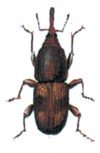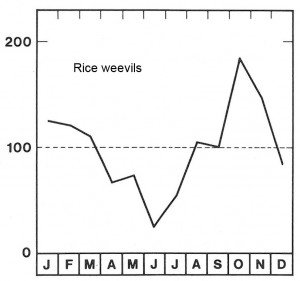

Latin: Sitophilus oryzae.
Very similar to the granary weevil, and you cannot tell the difference with the naked eye. With a little magnification however, it is possible to see that the rice weevil has four red spots on the elytrons. The rice weevil is on average slightly smaller and moves faster than the granary weevil. The rice weevil, unlike the granary weevil, flies, and in its natural habitats, in warm countries, it infests grain while it matures in the fields. In Northern Europe, however, it is most common in imported cereals, mainly rice. In terms of biology and harmfulness rice- and granary weevils are very similar, but the rice weevils’ multiplication rate is twice as high when conditions are right.
The rice weevil cannot survive the winter in warehouses with temperatures below 10 ° C. 3 weeks at 0 ° C kill eggs, larvae and adult beetles. Deep freezing is therefore an effective measure against rice weevils. In larger parties, fumigation with phosphoresced hydrogen is the solution.




